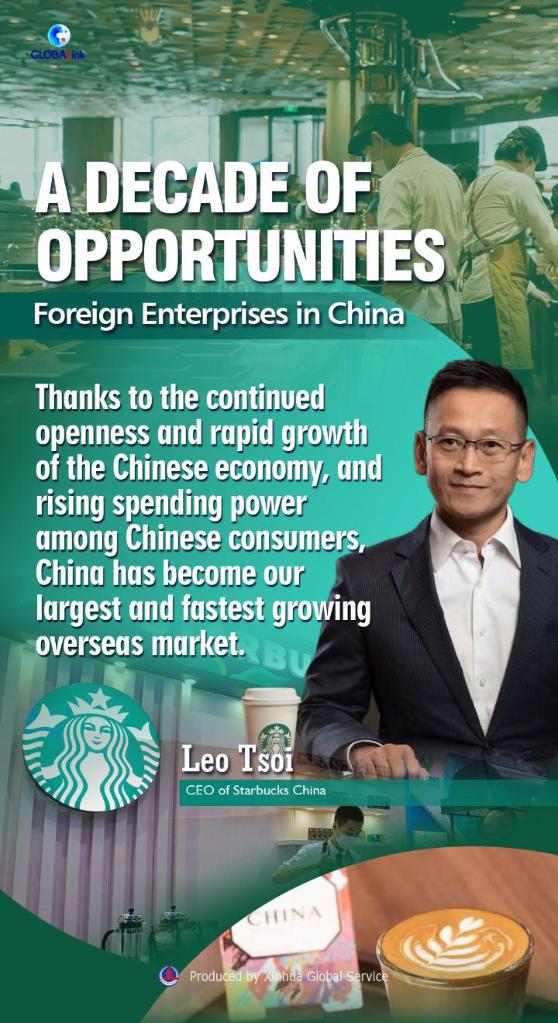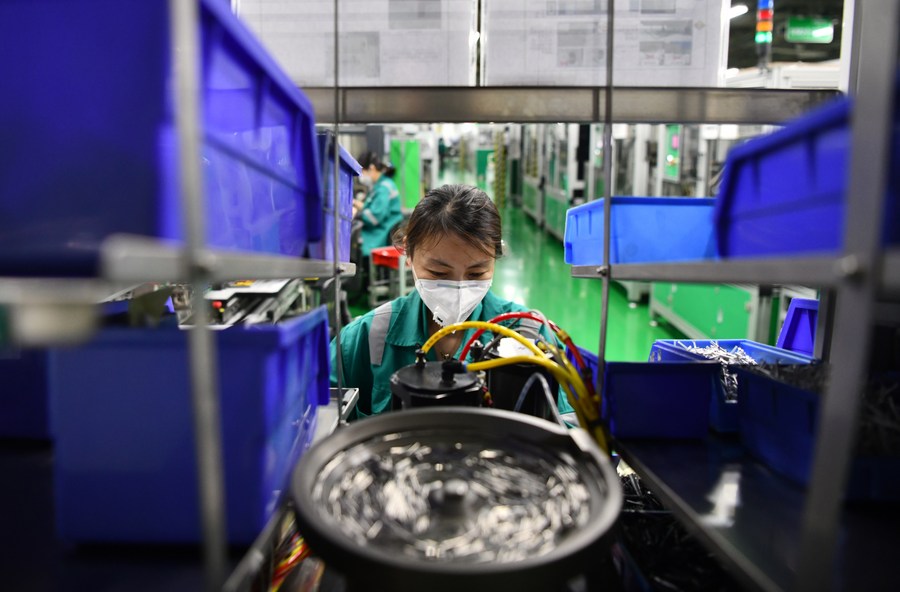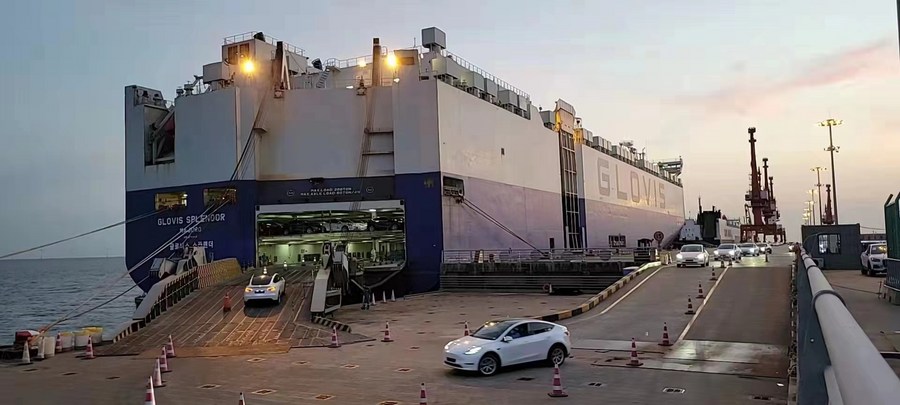Foreign enterprises in China: a decade of opportunities and transformation
* The past decade has turned into opportunities and transformation for foreign enterprises in China, with profound changes taking place in foreign investment in terms of amount, structure, and degree of participation.
* Foreign investment has flown into new areas in the Chinese economy, which is following the guidance of a new development philosophy featuring innovative, coordinated, green, open, and shared growth.
* New opportunities have also come from China's efforts to promote high-level opening-up, which has not only encouraged the flow of goods and production factors but also steadily expanded institutional opening-up based on rules, regulations, management, and standards.
BEIJING, July 21 (Xinhua) -- In January 1999, Starbucks entered the Chinese mainland market by opening its first store in the China World Trade Center, Beijing's most popular commercial center.
But with a latte priced at around 20 yuan (about 2.4 U.S. dollars back then) and the average monthly salary of Beijing residents just surpassing 1,000 yuan, coffee was a niche market at that time.
It took several years for the U.S. coffee chain to get traction in the Chinese market. Since 2010, China has risen to become the largest overseas market for Starbucks. Over the past decade, the number of Starbucks stores jumped by about 9 times to over 5,700 across the country.
"We are a witness of China's fast and steady urbanization," Leo Tsoi, chief executive officer of Starbucks China, told Xinhua. He described the company's past decade of development in China as "faster, broader, and deeper."

Apart from metropolises like Beijing and Shanghai, Starbucks China has opened more stores in smaller cities and townships and aims for 6,000 stores by the end of this year, according to Tsoi.
Starbucks' story is a telling example of how the past decade turned into opportunities and transformation for foreign enterprises in China, during which profound changes have taken place in foreign investment in terms of amount, structure, and degree of participation.
Despite the rising deglobalization trend and protectionism, in 2021, China's actual use of foreign direct investment (FDI) reached 1.15 trillion yuan (about 170 billion U.S. dollars), ranking second in the world, up 62.9 percent from 2012.
In the same period, global FDI only grew around 27 percent to 1.65 trillion U.S. dollars, according to the United Nations Conference on Trade and Development.
The strong increase has proven unnecessary the worries that China would lose its appeal to foreign investors after it abolished preferential policies for foreign firms over a decade ago. In addition to advantages in labor and costs, the country's steady development and huge market potential have kept drawing investment inbound.
From 2012 to 2021, China's GDP grew from 53.9 trillion yuan to 114.4 trillion yuan. Its per capita disposable income reached 32,189 yuan in 2020, more than double the level in 2010, official data showed.
The country is now the world's second-largest consumer market, boasting a middle-income group of over 400 million people.
"Thanks to the continued openness and rapid growth of the Chinese economy, and rising spending power among Chinese consumers, China has become our largest and fastest growing overseas market," Tsoi said.

Staff members work at the Starbucks Reserve Roastery in Shanghai, east China, June 3, 2022. (Xinhua/Liu Ying)
PARTICIPANTS IN HIGH-QUALITY DEVELOPMENT
Along with scale expansion, China's pursuit of a new development pattern in recent years, which focused on improving the quality of growth and unleashing new development impetus, has also transformed the landscape of foreign investment.
Foreign investment has flown into new areas in the Chinese economy, which is following the guidance of a new development philosophy featuring innovative, coordinated, green, open, and shared growth.
In the manufacturing sector, a key economic driver, multinationals have been moving up the value chain in their China investments over the years.
China's high-tech manufacturing sector used 12.06 billion U.S. dollars of foreign investment in 2021, or 35.8 percent of the total foreign investment used in the manufacturing sector, said a report released by a research institute under the Ministry of Commerce.
This represented a rise of 6.3 percentage points in proportion from the 2017 level, when 9.89 billion dollars of foreign investment were used in the high-tech manufacturing sector, according to the report.
Li Jing, partner of climate change and sustainability services of Ernst &Young (EY) Greater China, said under China's carbon peaking and neutrality goals, she is optimistic about sectors related to ESG (environmental, social, and governance), climate change and green finance in the Chinese market.
To grasp the opportunities, according to Li, the global consulting firm has established an ESG management committee in China to promote not only its own practice of sustainable development, but also to provide green development and low carbon transformation solutions for companies.
In the view of Yin Zheng, executive vice president of Schneider Electric and president of Schneider Electric China, the appeal of the Chinese market comes not only from the super large scale but also from the complete industrial chain, favorable innovation environment, and talent resources.

China is the only country in the world with all industrial categories listed in the United Nations industrial classification. On the innovation front, the country rose to 12th on the Global Innovation Index 2021, up from the 34th in 2012, according to the World Intellectual Property Organization.
In Shanghai alone, as of the end of May this year, multinational companies have set up 848 regional headquarters and 512 foreign-invested R&D centers.
In 2020, the Starbucks China Coffee Innovation Park broke ground in east China's Jiangsu Province to strengthen coffee roasting and supply chain management in the country.
The nearly 1.1-billion-yuan project is Starbucks' largest manufacturing investment internationally. Upon completion, coffee beans from worldwide will be processed, roasted, packaged, and distributed in China, according to the company.
China has become one of Schneider Electric's largest R&D bases around the globe, according to Yin. Currently, there are over 1,800 engineers on the company's R&D team in China, an increase of nearly 30 percent over the past three years.
"China is one of the most competitive and innovative markets in the world. Maintaining a leading position in the Chinese market helps us better succeed globally," Yin told Xinhua.

An employee works at Schneider Electric Low Voltage (Tianjin) Co., Ltd. in Tianjin, north China, Feb. 25, 2020. (Xinhua/Li Ran)
CAPITALIZING ON HIGH-LEVEL OPENING-UP
For foreign investors, new opportunities also came from China's efforts to promote high-level opening-up, which has not only encouraged the flow of goods and production factors but also steadily expanded institutional opening-up based on rules, regulations, management, and standards.
In 2013, China set up its first pilot free trade zone (FTZ) in Shanghai, the testbed of new economic policies. After five rounds of expansion, China now has 21 such zones.
The country has kept shortening the negative list for foreign investment and put into force laws and regulations, including the Foreign Investment Law, to protect the legitimate rights and interests of foreign investors.
China's business environment is also improving, with its ease of doing business ranking ascending to 31 from 91 in 2012, according to a World Bank report.
In 2018, China removed restrictions on foreign investment in new energy vehicles. Shortly afterward, Tesla established China's first wholly foreign-owned car manufacturing enterprise in Shanghai, which started construction in early 2019 and delivered its first batch of made-in-China vehicles within a year.
Behind the rapid speed was the institutional innovation of the Shanghai FTZ. According to authorities of the Lingang new area of the Shanghai FTZ, the efficient approval processes are being replicated for all investment projects in the new area.
In the first half of this year, the Tesla Shanghai Gigafactory exported 97,182 vehicles to the overseas market, more than double the level a year ago despite the resurgence of COVID-19.

Electric cars produced by U.S. automaker Tesla's Shanghai Gigafactory are loaded onto a cargo ship at Nangang port in Shanghai, east China, May 11, 2022. (Xinhua)
China's unwavering opening-up efforts have also kept foreign enterprises optimistic despite the near-term headwinds from the pandemic.
The American Chamber of Commerce in China said in a recent white paper that about two-thirds of the companies surveyed listed China as one of the world's top three investment destinations, and about 83 percent of them said that they did not consider moving production or procurement outside China.
"China is one of the world's most dynamic and innovative markets. We have huge aspirations for Starbucks China in the next decade," said Tsoi.
Photos
Related Stories
- Ireland's imports hit new high as imports from China more than double
- Chinese-invested economic zone in Cambodia registers trade increase of 38 pct in H1
- Foreign companies eye opportunities in western China's green industries
- Young Africans see China as most influential country
- Philippines' Davao City eyes more Chinese investments in agriculture, manufacturing
Copyright © 2022 People's Daily Online. All Rights Reserved.









